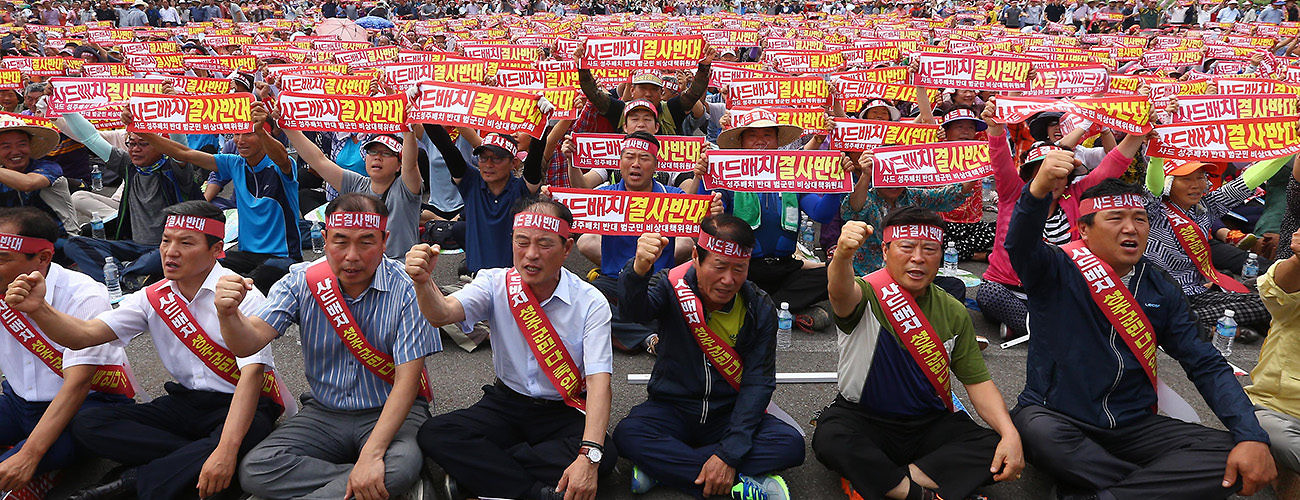Residents of the area where the THAAD missile system is due to be deployed protest the decision. Seongju, South Korea, July 13, 2016. (Kim Jun-bum/Yonhap/Associated Press)
In response to growing North Korean missile capabilities, the United States and South Korea decided on July 8 to deploy the much-debated Terminal High Altitude Area Defense (THAAD) system. Washington has for over two years publicly worked to add the anti-ballistic missile system under US Forces Korea command, and has even committed to pay for the system. But what will the decision mean for managing future tensions on the Korean Peninsula?
After Pyongyang’s fourth nuclear weapons test in January and a series of missile launches this year—including a satellite launch/and intercontinental ballistic missile test in February—Seoul agreed to sit down to formal discussions on THAAD deployment. Negotiations were difficult to get off the ground, as South Korean leaders struggled with how to manage external pressure from neighboring countries. China, in particular, has bristled at the decision, arguing that it impedes productive dialogue with North Korea and also interferes with its own security.
Beijing is not concerned about whether or not a missile from the THAAD battery could shoot down a Chinese ballistic missile, rather that the radar technology might be used for surveillance to feed data elsewhere in the US ballistic missile defense system. Some US analysts argue that such concerns are unwarranted, and that Beijing has yet to provide a convincing argument for how specifically THAAD would impede China’s security. Ultimately, Beijing worries that the system would “inevitably” target Russia and China. Following the deployment decision, Chinese state media likened the consequences to the Cuban Missile Crisis, claiming it presented a “clear, present, and substantive threat to China’s security interests.”
The Chinese ambassador to South Korea warned in February this year that THAAD deployment would destroy bilateral ties “in an instant,” while a July 15 China Daily editorial framed the decision as a strategic choice on the part of South Korea, which had purportedly “turn[ed] its back on China.” While the editorial granted that Seoul faced legitimate security concerns vis-à-vis Pyongyang’s threats of launching a nuclear attack, it argued that THAAD was not only too strong, but poorly matched for responding to this threat. Under the circumstances, it called for a reassessment of Chinese policies toward South Korea.
Seoul’s decision also takes into consideration domestic concerns. According to a May 2016 think tank poll, nearly 74% of South Koreans support THAAD deployment, up 12.5% from 2015. Deployment received majority support among both conservatives (84% in favor) and progressives (61%). These figures track with the broader strategic outlook of Korean civil society. Many South Koreans are wary of the implications China’s economic and military rise, and still look favorably on their comprehensive partnership and mutual defense treaty with the US. While several contentious bilateral issues continue to bubble beneath the surface, by and large the US receives much wider South Korean popular support than China, both as cooperative partner and global leader, and the public predicts this gap to widen further going forward.
Nonetheless, the selection of Seongju, a rural county in the southeastern part of the country, as the site for THAAD deployment has provoked protests from local citizens both in the county and in Seoul. This is less on the basis of the diplomatic fallout and more about concerns over the health effects of the system’s radar emissions.
North Korea military threatened in a statement on July 11 to take “physical action” following the joint THAAD decision, a threat amplified by a missile test that Pyongyang claimed simulated a nuclear-missile attack on US assets in South Korea. The THAAD announcement thus piles onto already-deteriorating relations between Washington and Pyongyang. Following the July 7 round of US sanctions that targeted high-level North Korean officials (including leader Kim Jong-un) for human rights abuses, Pyongyang announced it would suspend its major channel of communication to the US through the United Nations. Instead, North Korea says it will now treat all issues with the US under its wartime law.
These strong and worried responses from regional players may, however, give the wrong impression that THAAD—or any specific weapons system—can quickly and completely transform the North Korea issue. As Jonathan Pollack of the Brookings Institution astutely put it, THAAD, or any missile defense system, is not a panacea for responding to the North Korean threat. But understanding the scope and limitations of this system is necessary for diplomatic progress for all countries involved. On the one hand, increasing defense and deterrence against a North Korean threat is vitally important to regional security, particularly in light of Pyongyang’s successful medium-range Musudan missile test in June.
Threats of a preemptive nuclear strike on US assets in South Korea and a return to wartime law understandably instill fear in South Korea and its major security partner. In disrupting regional stability it should be worrisome to China as well. On the other hand, because it views the US posture on the Korean peninsula with a distrustful eye, Beijing regards any move to heighten security that involves Washington as having ulterior motives.
With China bristling at the US-South Korea decision, any incentive for Pyongyang to come to the table to discuss denuclerization or other forms of arms reduction seems unlikely, short of intense and imminent escalation of tension on the peninsula. Due to the different interpretations of THAAD capabilities, in the near-term the decision makes it extremely difficult for all parties to return to negotiations, six-party or otherwise.
Darcie Draudt is a PhD student in Political Science at Johns Hopkins University, a non-resident James A. Kelly Korean Studies Fellow at Pacific Forum CSIS, and Director of Research at Sino-NK.





